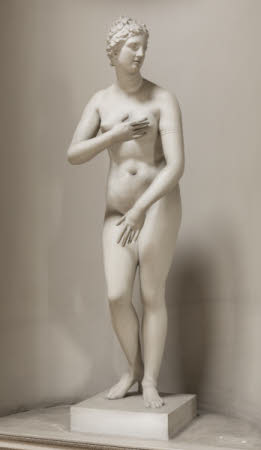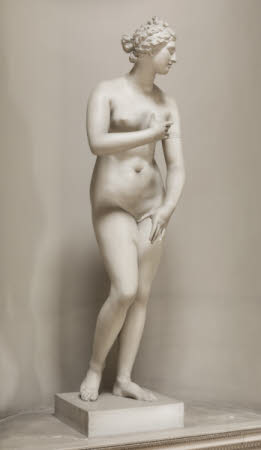Venus de' Medici (II)
Italian (Florentine) School
Category
Art / Sculpture
Date
circa 1756 - circa 1758
Materials
Painted plaster
Measurements
1530 x 475 mm
Place of origin
Florence
Order this imageCollection
Kedleston Hall, Derbyshire
NT 109010
Summary
Painted plaster, the Venus de' Medici (II), Italian School, cast c. 1756-58. One of two plaster casts at Kedleston of the Venus de' Medici, with NT 109004, cast after the antique marble in the Uffizi, Florence. A full-length statue of Venus, turning to proper left, nude, covering her breast with her proper right hand, and her lower half with her left hand. The statue is mounted on a square plaster base. The statue is cast after a Hellenistic marble in the Tribuna of the Uffizi, Florence. The marble was first recorded in the Villa Medici, Rome, in 1683; it was sent to Florence in 1677 and by 1688 it had been installed in the Tribuna (see Haskell and Penny 1981, pp. 325-28, no. 88, fig. 173).
Full description
The two casts of the Venus de' Medici [NT 109004 and 109010] were probably acquired for Nathaniel Curzon (1726-1804) around 1756-8 by the sculptor Joseph Wilton (1722-1803). One of the Venuses is understood to have been in Curzon's possession from at least 1756, owed to a bill for that year (receipted 12 February 1757) from the sculptor John Cheere (1709-87) who charged for the service of 'Cleaning ye two statues of ye Venus [NT 109004 or 109010] & Faune [NT 109003 or 109009], & polishing them' (MS, Kedleston Archive). This suggests that the casts had been acquired second-hand and also explains why there are four casts of the Medici Venus and the Dancing Faun - two must have been purchased earlier, second-hand. The two further casts of the Medici Venus [NT 109004 or 109010] and Dancing Faun [NT 109003 or 109009] were acquired between 1756 and 1758 along with six other Florentine casts. A surviving bill from Joseph Wilton dated August 1757 accounts for only four of them: 'The Wrestler [departed], 'the Grinder [departed], 'Venus washing' [NT 109014], and the 'Bacchus of Sansovino' [NT 108991]. No bills or receipts exist for the Dancing Faun[s], the Venus de Medici[s], The Idolino [NT 109005], and the 'Mercury of Florence' [departed; not to be confused with NT 109012, Bateman's Mercury, cast acquired 1758 by Richard Hayward]. Two casts of Venus are recorded in a handwritten inventory of sculpture and statuary produced by Curzon himself in around 1760 (MS, Kedleston Archive). They are recorded again in a list inscribed on the verso of that inventory, under the subheading 'Saloon Statues'. Both Venuses were initially installed in the Saloon (see 'Catalogue of the pictures, statues, &c. at Kedleston', 1758, Saloon, p. 9) but by c. 1788-89, when the Saloon was converted into a ballroom, they had been moved to the Marble Hall, where they stand today (see Catalogue of 1769, p. 7, see annotated copy in the Getty Research Institute, Los Angeles). Joseph Wilton lived in Florence from 1751 to 1755, following three years in Rome producing copies and casts of antique sculpture with Matthew Brettingham (1725-1803), the dealer and cast-maker responsible for all of statues at Kedleston cast after Roman antiquities. Unlike Matthew Brettingham, who acquired the actual moulds for some of the Roman statuary he cast for Kedleston, Wilton probably had the casts made through an agency in Florence. Alice Rylance-Watson March 2019
Provenance
Purchased by Nathaniel Curzon, 1st Baron Scarsdale (1726-1804), probably from Joseph Wilton (1722-1803) c. 1756-8; identifiable in the 'Catalogue of the pictures, statues, &c. at Kedleston' of 1758 (Saloon, p. 9), of 1769 and 1861 (Marble Hall, p. 7); purchased with part of the contents of Kedleston with the aid of the National Heritage Memorial Fund in 1987 when the house and park were given to the National Trust by Francis Curzon, 3rd Viscount Scarsdale (1924-2000).
Credit line
Kedleston Hall, The Scarsdale Collection (acquired with the help of the National Heritage Memorial Fund and transferred to the National Trust in 1987)
Makers and roles
Italian (Florentine) School, caster Joseph Wilton (London 1722 - Wanstead 1803), dealer
References
Haskell and Penny 1981: Francis Haskell and Nicholas Penny, Taste and the Antique, The Lure of Classical Sculpture 1500 - 1900, New Haven and London, 1981, pp. 325 - 28, no. 88, fif. 173. Kenworthy-Browne 1993: John Kenworthy-Browne, ‘Designing around the statues. Matthew Brettingham’s casts at Kedleston’, Apollo, April 1993, pp.248-252





